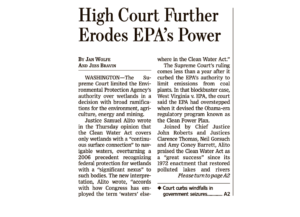“In 2015 the Obama administration widened the scope of the law to cover even ephemeral streams and ponds. North Dakota, Wyoming, Alaska and other states immediately sued in federal court, resulting in a nationwide stay from a federal appeals court in Ohio. As the challenges dragged on and led to a slew of different rulings, the Trump-era EPA repealed the rule and in 2019 created a new, weaker one.
Supreme Court Limits EPA’s Authority Over Wetlands
Jan Wolfe and Jess Bravin reported on the front page of today’s Wall Street Journal that, “The Supreme Court limited the Environmental Protection Agency’s authority over wetlands in a decision with broad ramifications for the environment, agriculture, energy and mining.
“Justice Samuel Alito wrote in the Thursday opinion that the Clean Water Act covers only wetlands with a ‘continuous surface connection‘ to navigable waters, overturning a 2006 precedent recognizing federal protection for wetlands with a ‘significant nexus‘ to such bodies. The new interpretation, Alito wrote, ‘accords with how Congress has employed the term ‘waters’ elsewhere in the Clean Water Act.'”

The Journal article noted that, “[Alito] characterized the decision as resolving a ‘nagging question’ over the act’s outer boundaries, which the vague language Congress used to define its scope—it protects the ‘waters of the U.S.‘—left unclear.
“‘Does the term encompass any backyard that is soggy enough for some minimum period of time?’ he wrote. ‘How about ditches, swimming pools, and puddles?’
“The court, he wrote, had now provided an answer that would spare property owners the sometimes great expense and even potential criminal liability for misjudging whether their projects were covered by the Clean Water Act.”
Wolfe and Bravin pointed out that, “The Clean Water Act prohibits the ‘discharge of pollutants,’ including rocks and sand, into ‘navigable waters.’
“The EPA has interpreted its jurisdiction broadly to include some wetlands that aren’t directly connected to a body of water, an interpretation it says is necessary to protect against water pollution and consistent with Congress’s intent in passing the landmark environmental-protection law.
“There has been fierce debate about what areas fall within the statute’s jurisdiction ever since its enactment.”
Today’s article indicated that,
Farmers’ advocates applauded the high court’s decision, saying it would make it easier for them to do their job with less interference from federal agencies.
On the front page of today’s Washington Post, Robert Barnes, Timothy Puko and Ann E. Marimow reported that, “All of the justices agreed that federal regulators went too far in the case at hand, which involved an Idaho couple’s quest to build a home near a lake. But instead of a narrow decision saying just that, the court majority sided with a decades-long effort by property rights groups and businesses to narrow regulations to wetlands and other areas directly connected to ‘navigable waters’ such as rivers and lakes.”

The Post article noted that, “It gives a win to farmers, home builders and other developers that will now probably find it easier to get permits to build, lawyers and trade groups said. And it probably will force the Biden administration to abandon — or at least restart — an effort it began in 2021 to resolve years of uncertainty with new definitions on the type of waterways EPA rules can protect, leaving more of that power up to state governments, lawyers and legal experts said.”
Today’s article also provided background on executive branch actions related to wetlands: “The fight over what constitutes a wetland subject to the CWA has raged for decades. The George W. Bush administration first issued guidance limiting the reach of the Clean Water Act in 2003 and 2008, after earlier Supreme Court decisions.
“The Biden administration has tried to strike a balance by undoing the Trump-era rule and redefining EPA oversight as covering ‘traditional navigable waters,’ including interstate waterways and upstream water sources that influence the health and quality of those waterways.”
David G. Savage reported on the front page of today’s Los Angeles Times that, “Thursday’s decision effectively overturns a moderate position set by Justice Anthony M. Kennedy in 2006. He said the law should protect marshy areas or dry creek beds that sometimes send water flowing into a river or bay, rejecting Scalia’s view that the EPA could protect only continuously flowing bodies of water.
“But with the addition of Justices Neil M. Gorsuch and Amy Coney Barrett, the court has adopted Scalia’s view and cast aside Kennedy’s.
“Thursday’s ruling limiting the EPA does not prevent California or other states from protecting their wetlands. But developers, home builders and farmers argue that they should not be prevented from using land that includes marsh areas.”
And Adam Liptak, writing in today’s New York Times, reported that, “Kevin Minoli, who worked as a senior E.P.A. lawyer from the Clinton through the Trump administrations, overseeing the enforcement of Clean Water Act regulations, said the decision would have enormous practical consequences and estimated that it would affect more than half the nation’s wetlands.”





